Synchrotron Microanalytical Characterization and K/Ar Dating of the GL-O-1 Glauconite Reference Material at the Single Pellet Scale and Reassessment of the Age of Visually Mature Pellets
Abstract
1. Introduction
2. Methods
2.1. Synchrotron Measurements
2.2. Argon Measurements
2.3. Potassium Measurements
3. Results
3.1. Synchrotron Results
3.2. Argon Measurement Results/Nb Tubes
3.3. Argon Measurement Results/Compared with Other Ar Standards
3.4. Results from K Measurements by Electron Microprobe
3.5. Results from K Measurements by Isotope Dilution
4. Discussion
4.1. Caveats and Potential for Future Improvements
4.2. The Age of GL-O-1 and the Albian-Cenomanian Boundary
5. Conclusions
Supplementary Materials
Author Contributions
Funding
Data Availability Statement
Acknowledgments
Conflicts of Interest
References
- Harland, W.B.; Armstrong, R.L.; Cox, A.L.; Craig, L.E.; Smith, A.G. A Geologic Time Scale 1989; Cambridge University Press: Cambridge, UK, 1990. [Google Scholar]
- Interlaboratory Standards for Dating Purposes. In Numerical Dating in Stratigraphy; Gilles, O., Ed.; Wiley: Chichester, UK, 1982; pp. 123–148. [Google Scholar]
- Craig, L.E.; Smith, A.G.; Armstrong, R.L. Calibration of the Geologic Time Scale: Cenozoic and Late Cretaceous Glauconite and Nonglauconite Dates Compared. Geology 1989, 17, 830. [Google Scholar] [CrossRef]
- Ando, A. Recent Contributions to the Standard Albian/Cenomanian Boundary Chronology from Hokkaido, Japan: A Review for Data Reintegration and Numerical Age Recalibration. Cretac. Res. 2016, 64, 50–58. [Google Scholar] [CrossRef]
- Smith, P.E.; Evensen, N.M.; York, D.; Odin, G.S. Single-Grain 40Ar-39Ar Ages of Glauconies: Implications for the Geologic Time Scale and Global Sea Level Variations. Science 1998, 279, 1517–1519. [Google Scholar] [CrossRef]
- Odin, G.S.; Morton, A.C. Chapter 4 Authigenic Green Particles From Marine Environments. In Developments in Sedimentology; Elsevier: Amsterdam, The Netherlands, 1988; Volume 43, pp. 213–264. ISBN 978-0-444-42922-3. [Google Scholar]
- Boulesteix, T.; Solé, J.; Pi, T.; Cathelineau, M. Reappraisal of the GL-O Reference Material for K-Ar Dating: New Insight from Microanalysis, Single-Grain and Milligram Ar Measurements. Geostand. Geoanal. Res. 2020, 44, 287–306. [Google Scholar] [CrossRef]
- Selby, D. U-Pb Zircon Geochronology of the Aptian/Albian Boundary Implies That the GL-O International Glauconite Standard Is Anomalously Young. Cretac. Res. 2009, 30, 1263–1267. [Google Scholar] [CrossRef]
- Hemming, S.R.; Hall, C.M.; Biscaye, P.E.; Higgins, S.M.; Bond, G.C.; McManus, J.F.; Barber, D.C.; Andrews, J.T.; Broecker, W.S. 40Ar/39Ar Ages and 40Ar* Concentrations of Fine-Grained Sediment Fractions from North Atlantic Heinrich Layers. Chem. Geol. 2002, 182, 583–603. [Google Scholar] [CrossRef]
- Gombiner, J.H.; Hemming, S.R.; Hendy, I.L.; Bryce, J.G.; Blichert-Toft, J. Isotopic and Elemental Evidence for Scabland Flood Sediments Offshore Vancouver Island. Quat. Sci. Rev. 2016, 139, 129–137. [Google Scholar] [CrossRef]
- Hemming, S.R. New K/Ar Age Values and Context from Published Clay Mineralogy and Sr and Nd Isotopes as Tracers of Terrigenous Atlantic Ocean Sediments. Mar. Geol. 2019, 411, 36–50. [Google Scholar] [CrossRef]
- Portier, A.M.; Thierens, M.; Martin, E.E.; Hemming, S.R.; Gombiner, J.H.; Raymo, M.E. Late Pleistocene Emergence of Crystalline Canadian Shield Sources in Sediments of the Northern Gulf of Mexico. Paleoceanogr. Paleoclimatol. 2021, 36, e2020PA004082. [Google Scholar] [CrossRef]
- Bailey, I.; Hole, G.M.; Foster, G.L.; Wilson, P.A.; Storey, C.D.; Trueman, C.N.; Raymo, M.E. An Alternative Suggestion for the Pliocene Onset of Major Northern Hemisphere Glaciation Based on the Geochemical Provenance of North Atlantic Ocean Ice-Rafted Debris. Quat. Sci. Rev. 2013, 75, 181–194. [Google Scholar] [CrossRef]
- Coffey, G.L.; Savage, H.M.; Polissar, P.J.; Cox, S.E.; Hemming, S.R.; Winckler, G.; Bradbury, K.K. History of Earthquakes along the Creeping Section of the San Andreas Fault, California, USA. Geology 2022, 50, 516–521. [Google Scholar] [CrossRef]
- Northrup, P. The TES Beamline (8-BM) at NSLS-II: Tender-Energy Spatially Resolved X-Ray Absorption Spectroscopy and X-Ray Fluorescence Imaging. J. Synchrotron Radiat. 2019, 26, 2064–2074. [Google Scholar] [CrossRef] [PubMed]
- Ravel, B.; Newville, M. ATHENA, ARTEMIS, HEPHAESTUS: Data Analysis for X-Ray Absorption Spectroscopy Using IFEFFIT. J. Synchrotron Radiat. 2004, 12 Pt 4, 537–541. [Google Scholar]
- Kraft, S.; Stumpel, J.; Becker, P.; Kuetgens, U. High-Resolution X-Ray Absorption Spectroscopy with Absolute Energy Calibration for the Determination of Absorption Edge Energies. Rev. Sci. Instrum. 1996, 67, 681–687. [Google Scholar] [CrossRef]
- Newville, M. Larch: An Analysis Package for XAFS and Related Spectroscopies. J. Phys. Conf. Ser. 2013, 430, 12007. [Google Scholar] [CrossRef]
- Prescher, C.; Prakapenka, V.B. DIOPTAS: A Program for Reduction of Two-Dimensional X-Ray Diffraction Data and Data Exploration. High Press. Res. 2015, 35, 223–230. [Google Scholar] [CrossRef]
- Yager, K. SciToolsSciAnalysis 2.6.5. 2015. Available online: https://pypi.org/project/SciToolsSciAnalysis/ (accessed on 1 June 2023).
- McDougall, I.; Roksandic, Z. Total Fusion 40Ar/39Ar Ages Using Hifar Reactor. J. Geol. Soc. Aust. 1974, 21, 81–89. [Google Scholar] [CrossRef]
- Renne, P.R.; Swisher, C.C.; Deino, A.L.; Karner, D.B.; Owens, T.L.; DePaolo, D.J. Intercalibration of Standards, Absolute Ages and Uncertainties in 40Ar/39Ar Dating. Chem. Geol. 1998, 145, 117–152. [Google Scholar] [CrossRef]
- Samson, S.D.; Alexander, E.C. Calibration of the Interlaboratory 40Ar 39Ar Dating Standard, MMhb-1. Chem. Geol. Isot. Geosci. Sect. 1987, 66, 27–34. [Google Scholar] [CrossRef]
- López-Quirós, A.; Escutia, C.; Sánchez-Navas, A.; Nieto, F.; Garcia-Casco, A.; Martín-Algarra, A.; Evangelinos, D.; Salabarnada, A. Glaucony Authigenesis, Maturity and Alteration in the Weddell Sea: An Indicator of Paleoenvironmental Conditions before the Onset of Antarctic Glaciation. Sci. Rep. 2019, 9, 13580. [Google Scholar] [CrossRef]
- Marcus, M.A.; Westphal, A.J.; Fakra, S.C. Classification of Fe-Bearing Species from It K-Edge XANES Data Using Two-Parameter Correlation Plots. J. Synchrotron Radiat. 2008, 15, 463–468. [Google Scholar] [CrossRef] [PubMed]
- Chen, H.; Saunders, N.J.; Jerram, M.; Halliday, A.N. High-Precision Potassium Isotopic Measurements by Collision Cell Equipped MC-ICPMS. Chem. Geol. 2021, 578, 120281. [Google Scholar] [CrossRef]
- Wang, F.; Shi, W.; Guillou, H.; Zhang, W.; Yang, L.; Wu, L.; Wang, Y.; Zhu, R. A New Unspiked K-Ar Dating Approach Using Laser Fusion on Microsamples. Rapid Commun. Mass Spectrom. 2019, 33, 587–599. [Google Scholar] [CrossRef] [PubMed]
- Jourdan, F.; Renne, P.R. Age Calibration of the Fish Canyon Sanidine 40Ar/39Ar Dating Standard Using Primary K–Ar Standards. Geochim. Et Cosmochim. Acta 2007, 71, 387–402. [Google Scholar] [CrossRef]
- Jourdan, F.; Verati, C.; Féraud, G. Intercalibration of the Hb3gr 40Ar/39Ar Dating Standard. Chem. Geol. 2006, 231, 177–189. [Google Scholar] [CrossRef]
- Charbit, S.; Guillou, H.; Turpin, L. Cross Calibration of K–Ar Standard Minerals Using an Unspiked Ar Measurement Technique. Chem. Geol. 1998, 150, 147–159. [Google Scholar] [CrossRef]
- McDougall, I.; Wellman, P. Calibration of GA1550 Biotite Standard for K/Ar and 40Ar/39Ar Dating. Chem. Geol. 2011, 280, 19–25. [Google Scholar] [CrossRef]
- Min, K.; Mundil, R.; Renne, P.R.; Ludwig, K.R. A Test for Systematic Errors in 40Ar/39Ar Geochronology through Comparison with U/Pb Analysis of a 1.1-Ga Rhyolite. Geochim. Et Cosmochim. Acta 2000, 64, 73–98. [Google Scholar] [CrossRef]
- Redaa, A.A. New Geochronological Tool for Cu-Au Mineralisation in the Arabian Shield, Saudi Arabia: Testing In-Situ Rb-Sr Dating via LA-ICP-MS/MS. Ph.D. Thesis, The University of Adelaide, Adelaide, Australia, 2022. [Google Scholar]
- Kuiper, K.F.; Deino, A.; Hilgen, F.J.; Krijgsman, W.; Renne, P.R.; Wijbrans, J.R. Synchronizing Rock Clocks of Earth History. Science 2008, 320, 500–504. [Google Scholar] [CrossRef]
- Baldermann, A.; Warr, L.N.; Letofsky-Papst, I.; Mavromatis, V. Substantial Iron Sequestration during Green-Clay Authigenesis in Modern Deep-Sea Sediments. Nat. Geosci. 2015, 8, 885–889. [Google Scholar] [CrossRef]
- Baldermann, A.; Dietzel, M.; Mavromatis, V.; Mittermayr, F.; Warr, L.N.; Wemmer, K. The Role of Fe on the Formation and Diagenesis of Interstratified Glauconite-Smectite and Illite-Smectite: A Case Study of Upper Cretaceous Shallow-Water Carbonates. Chem. Geol. 2017, 453, 21–34. [Google Scholar] [CrossRef]
- Scheiblhofer, E.; Moser, U.; Löhr, S.; Wilmsen, M.; Farkaš, J.; Gallhofer, D.; Bäckström, A.M.; Zack, T.; Baldermann, A. Revisiting Glauconite Geochronology: Lessons Learned from In Situ Radiometric Dating of a Glauconite-Rich Cretaceous Shelfal Sequence. Minerals 2022, 12, 818. [Google Scholar] [CrossRef]
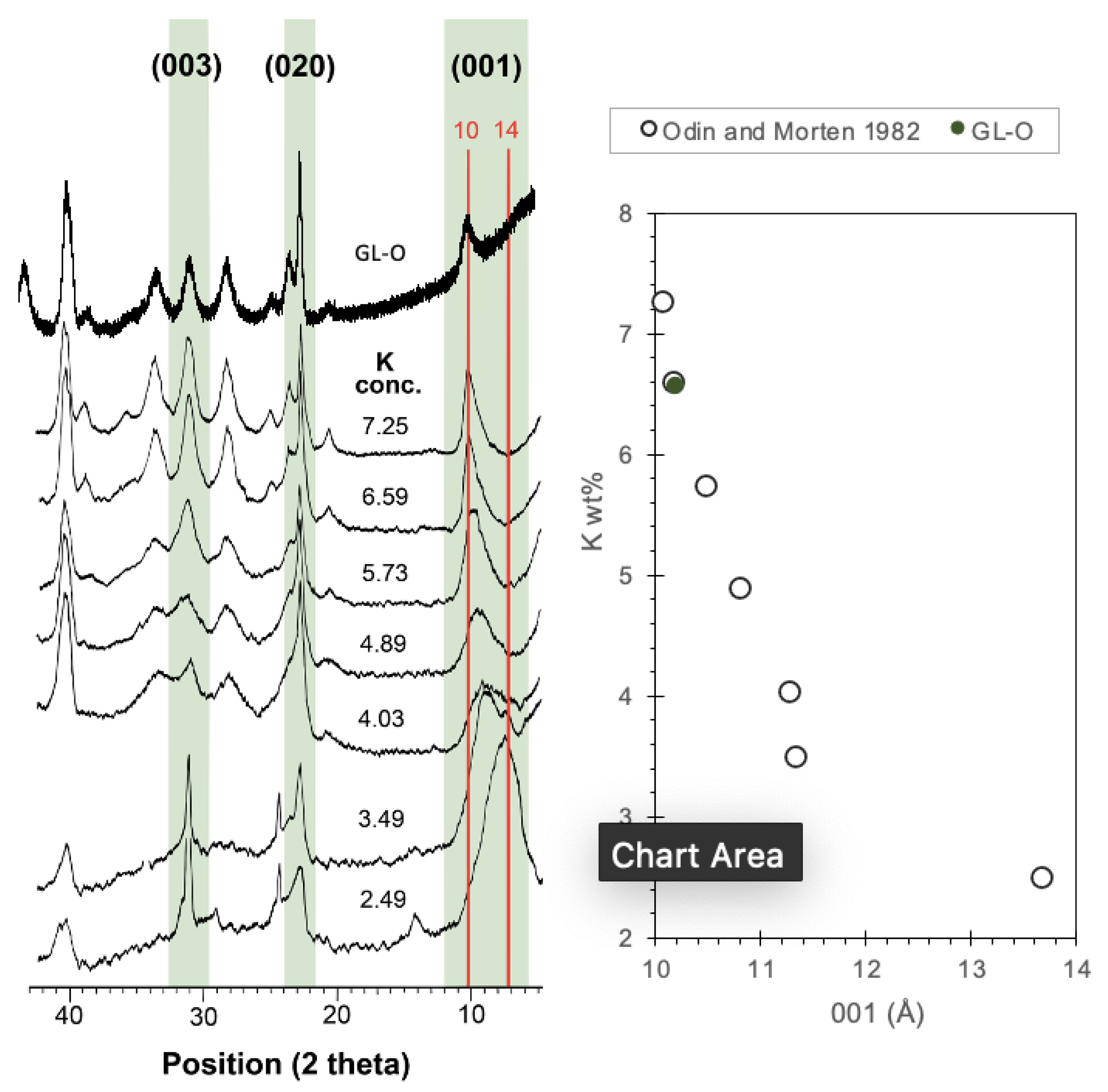
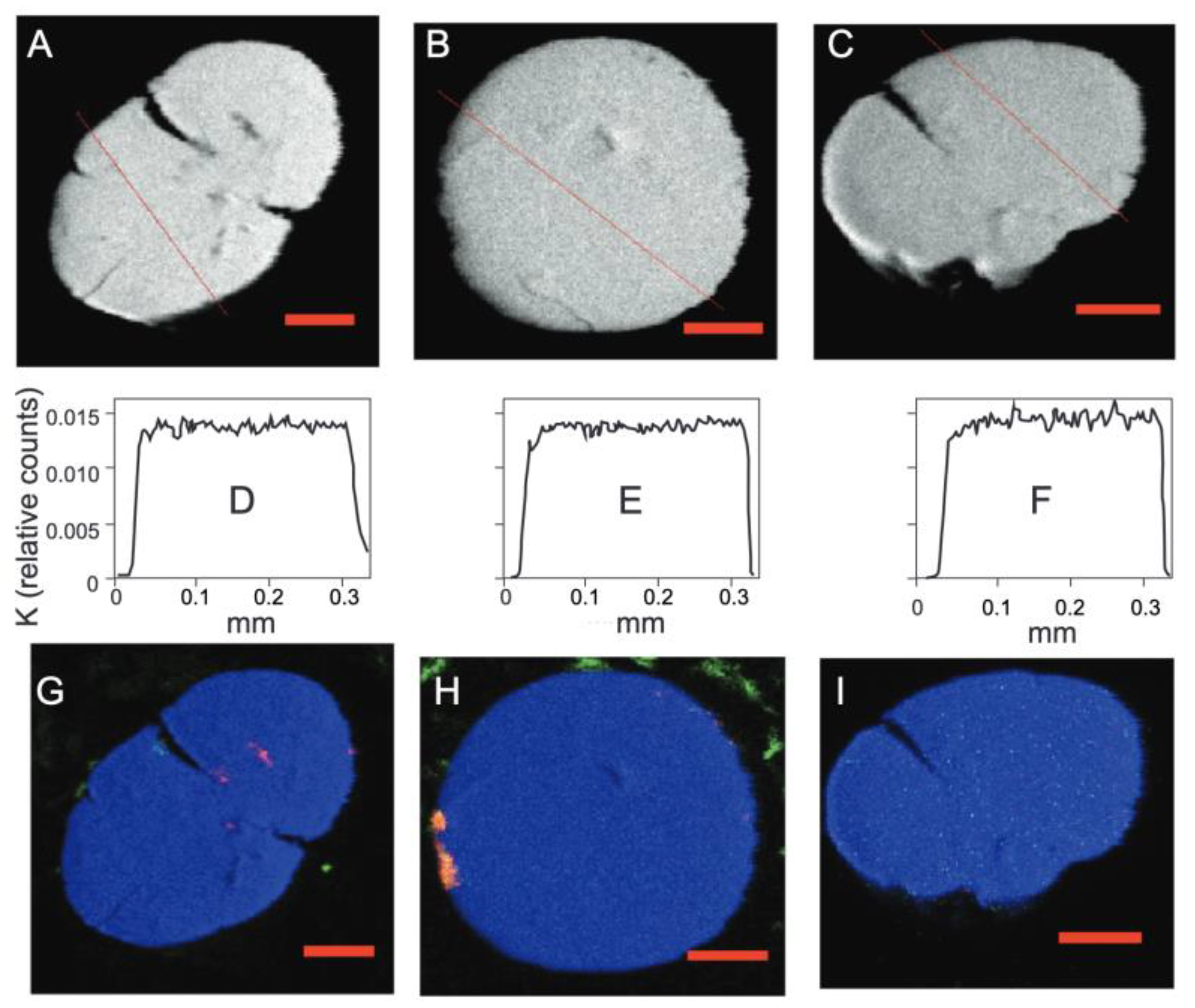
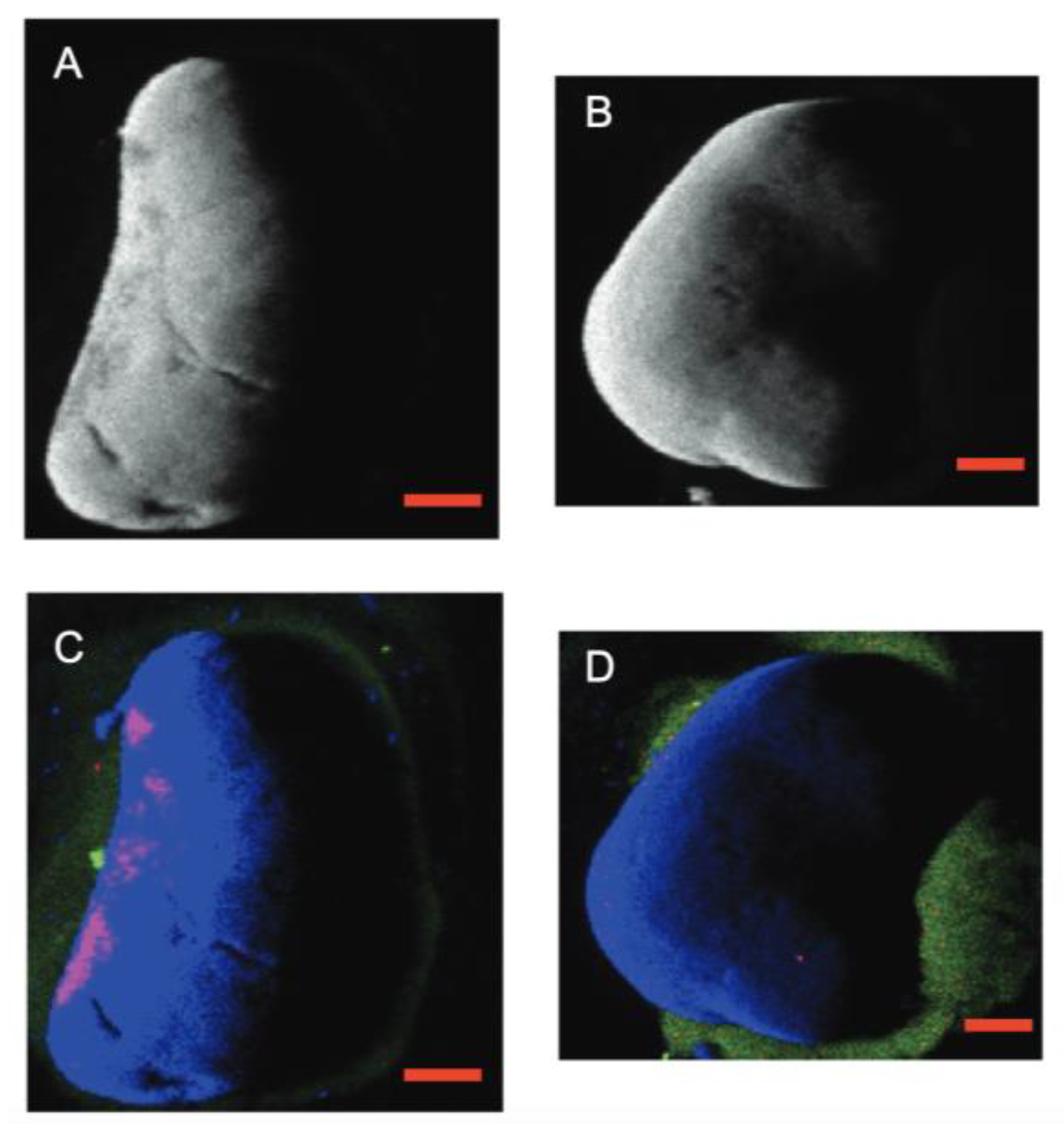
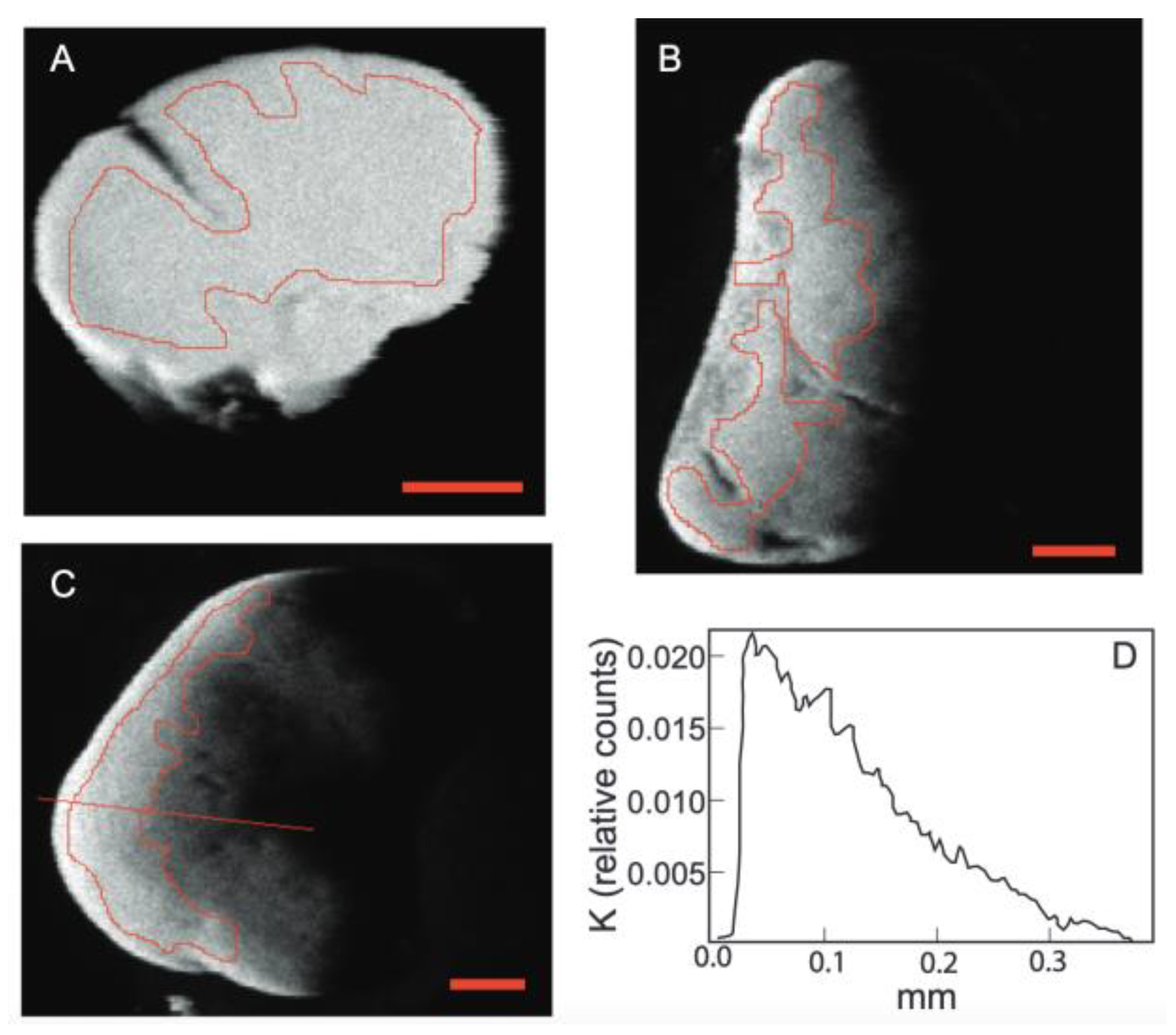
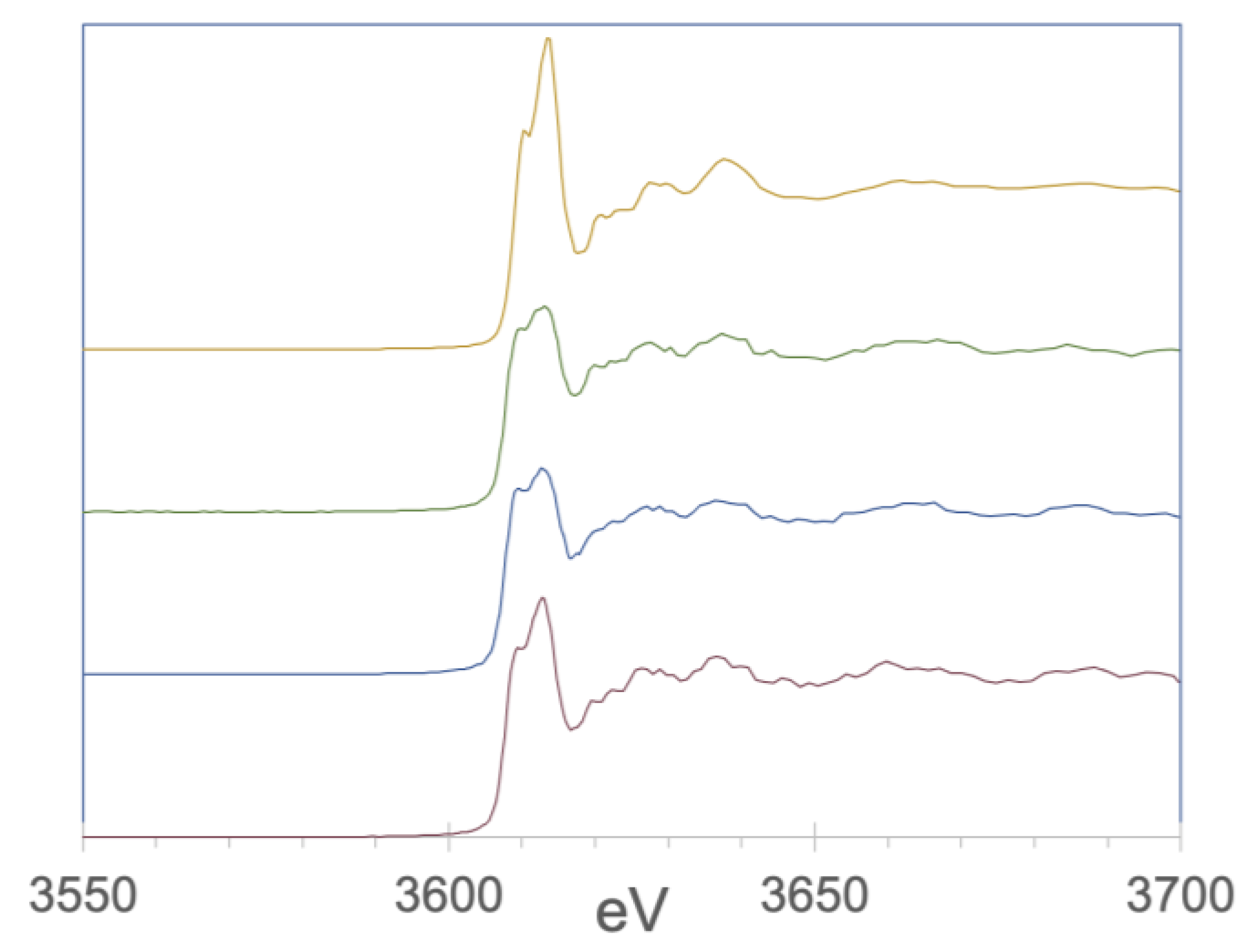

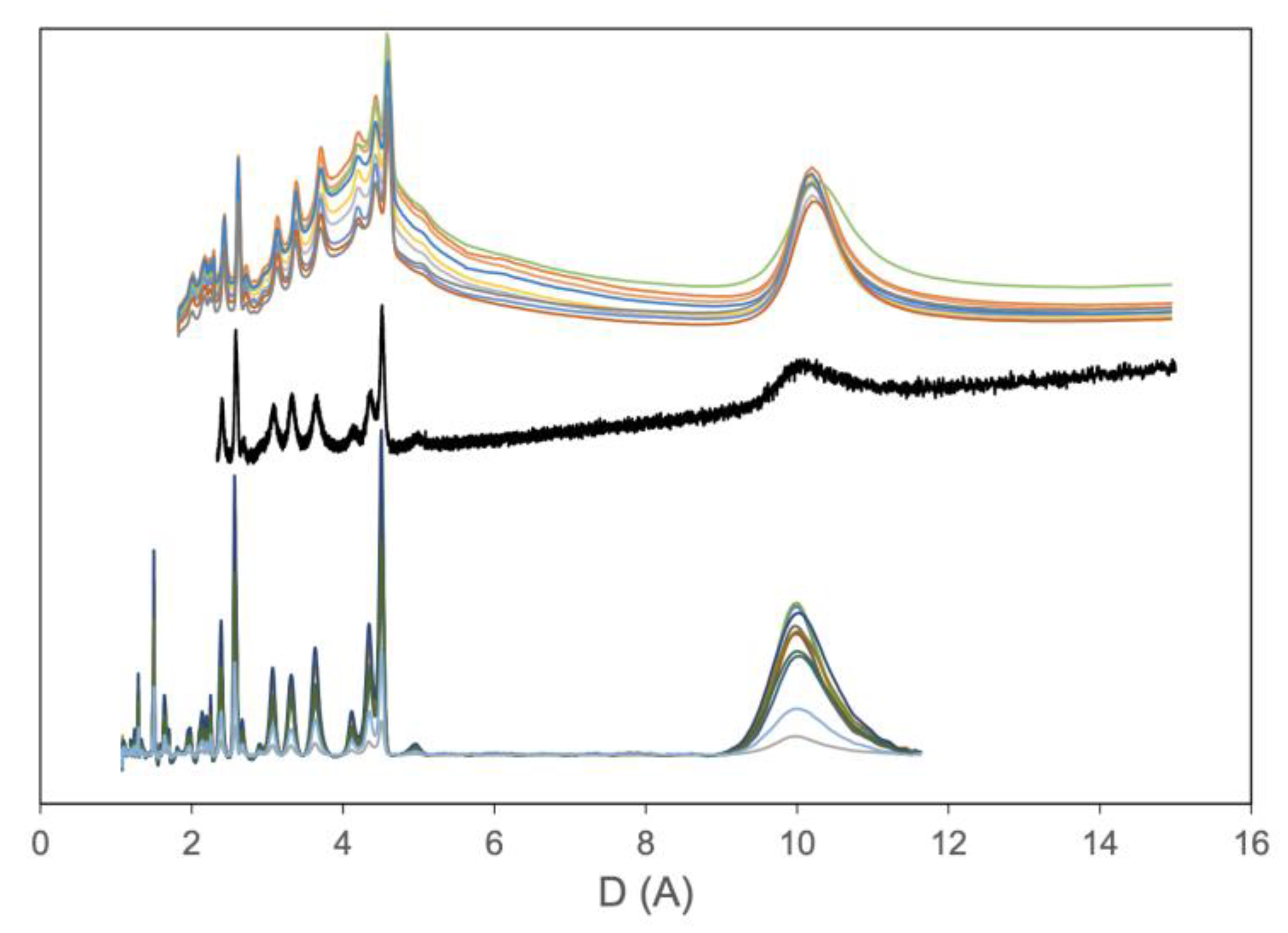
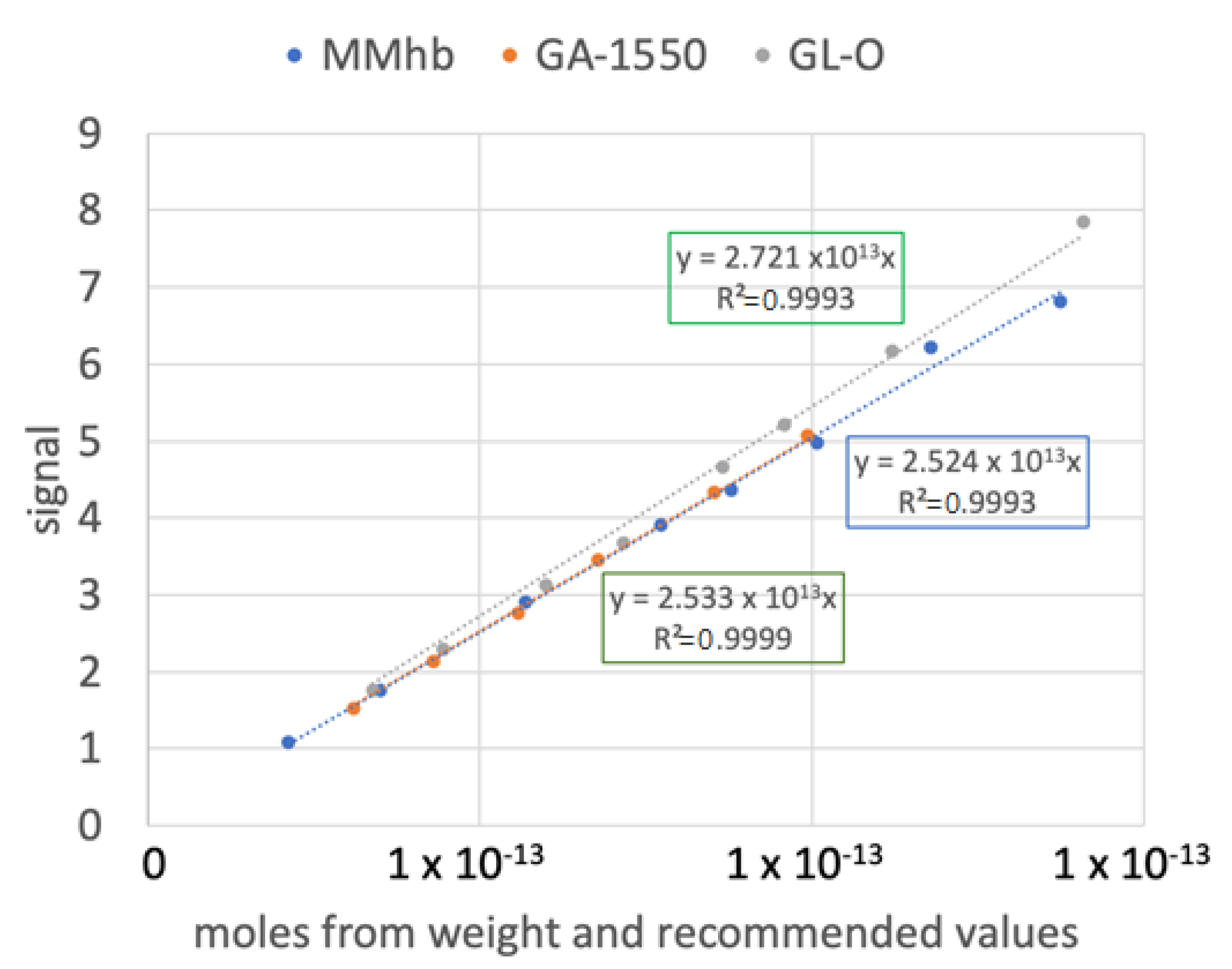
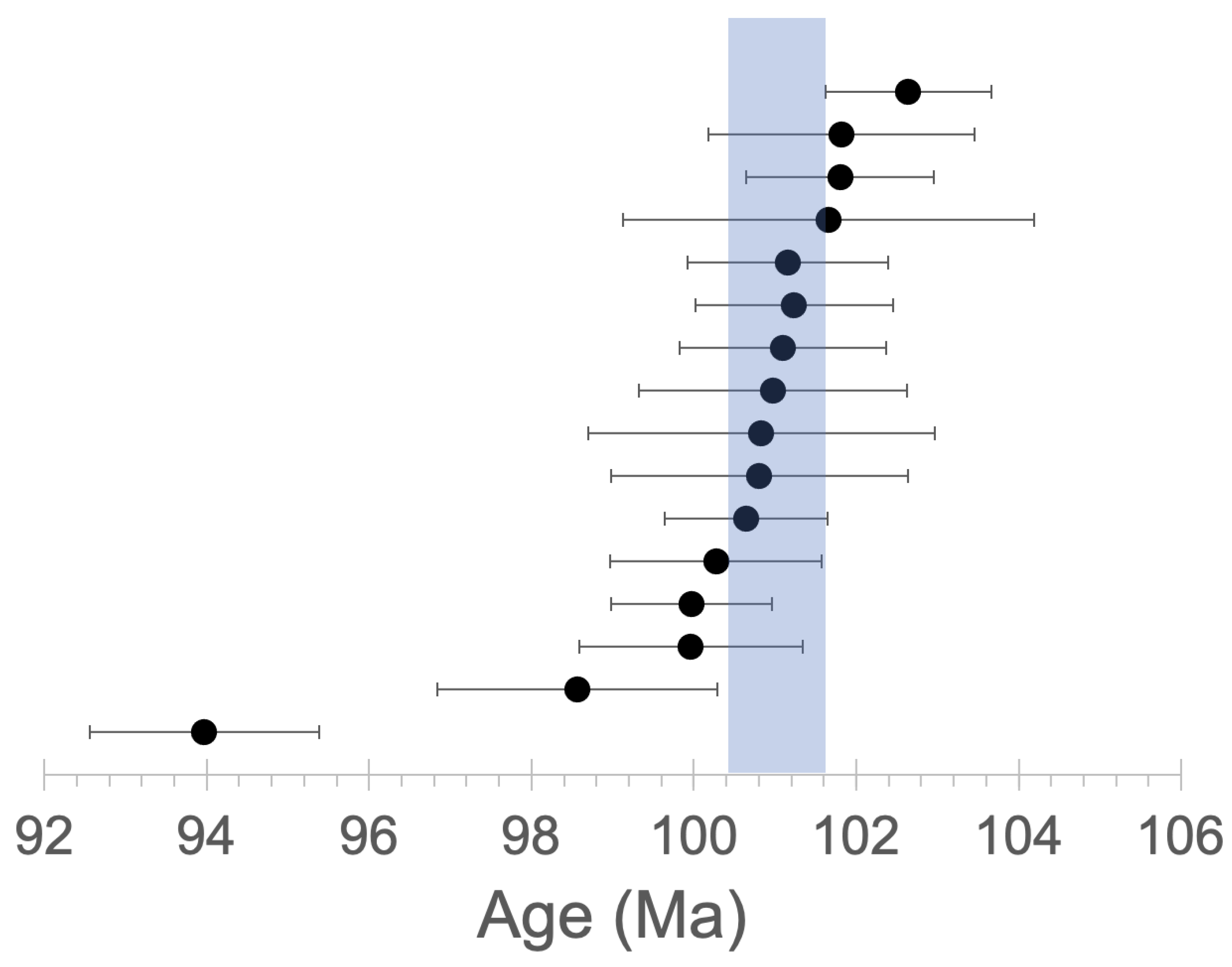
Disclaimer/Publisher’s Note: The statements, opinions and data contained in all publications are solely those of the individual author(s) and contributor(s) and not of MDPI and/or the editor(s). MDPI and/or the editor(s) disclaim responsibility for any injury to people or property resulting from any ideas, methods, instructions or products referred to in the content. |
© 2023 by the authors. Licensee MDPI, Basel, Switzerland. This article is an open access article distributed under the terms and conditions of the Creative Commons Attribution (CC BY) license (https://creativecommons.org/licenses/by/4.0/).
Share and Cite
Hemming, S.R.; Liu, T.; Northrup, P.; Nicholas, S.; Rasbury, E.T.; Chen, H.; Warden, A.; Chen, A.; Li, R.; Tappero, R.; et al. Synchrotron Microanalytical Characterization and K/Ar Dating of the GL-O-1 Glauconite Reference Material at the Single Pellet Scale and Reassessment of the Age of Visually Mature Pellets. Minerals 2023, 13, 773. https://doi.org/10.3390/min13060773
Hemming SR, Liu T, Northrup P, Nicholas S, Rasbury ET, Chen H, Warden A, Chen A, Li R, Tappero R, et al. Synchrotron Microanalytical Characterization and K/Ar Dating of the GL-O-1 Glauconite Reference Material at the Single Pellet Scale and Reassessment of the Age of Visually Mature Pellets. Minerals. 2023; 13(6):773. https://doi.org/10.3390/min13060773
Chicago/Turabian StyleHemming, Sidney R., Tanzhuo Liu, Paul Northrup, Sarah Nicholas, E. Troy Rasbury, Heng Chen, Alice Warden, Amanda Chen, Ruipeng Li, Ryan Tappero, and et al. 2023. "Synchrotron Microanalytical Characterization and K/Ar Dating of the GL-O-1 Glauconite Reference Material at the Single Pellet Scale and Reassessment of the Age of Visually Mature Pellets" Minerals 13, no. 6: 773. https://doi.org/10.3390/min13060773
APA StyleHemming, S. R., Liu, T., Northrup, P., Nicholas, S., Rasbury, E. T., Chen, H., Warden, A., Chen, A., Li, R., Tappero, R., Cox, S. E., Everard, J., Wang, S., Deluca, M., Bostick, B., & Halliday, A. N. (2023). Synchrotron Microanalytical Characterization and K/Ar Dating of the GL-O-1 Glauconite Reference Material at the Single Pellet Scale and Reassessment of the Age of Visually Mature Pellets. Minerals, 13(6), 773. https://doi.org/10.3390/min13060773





